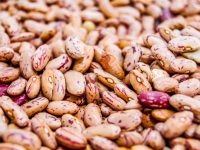Nothing beats a ripe piece of fruit for a perfect healthy snack. Maybe you’re tossing your dog a Milk Bone and wondering if you could perhaps share some fresh fruit instead. After all, your dog could spend forty calories on something natural and beneficial rather than a manufactured product. It’s been determined that there are many fruits that dogs can eat. But are plums one of them? Can dogs eat plums? Today we will explore the safety warnings of this fruit.
Can Dogs Eat Plums?
Plums are delicious in fresh form, but you can also enjoy them in meals, in sauces, or dried as a snack. Is it safe for man’s best friend to sample some of this purple fruit? Unfortunately, dogs should probably avoid eating plums.
The good news is that the flesh of plums isn’t toxic to dogs. This means if your dog samples a bit of a plum product, you will likely have no need to worry. However, plums can prove to be a dangerous food to navigate due to the central pit.
Plum Canine Cautions
Why should dogs pass on plums? The plum pit poses the largest threat to canine safety. Never give dogs fruit with the pit intact, because it can be extremely dangerous for them if ingested or even just chewed on.
For one, the pit is sharp. It could cause external cuts if bitten. The risks associated with eating the pit are even more concerning. Plum pits, and other fruit pits, could cause damage to your dog’s intestines, stomach, or esophagus. Additionally cyanide can be released into your dog’s body if the pit is crushed when ingested.
However, there is nothing inherently toxic about serving fresh, ripe plum flesh to dogs. Therefore it is safe to feed your dog small amounts of plum flesh that have been removed from the pit. You should check that the plum is not fermented, moldy, or overripe before sharing. Be sure to keep serving sizes small and to avoid the sugary canned plum variations.
What About Prunes?
Can dogs eat plums? No. What about prunes? Prunes may seem like the ideal solution. They are plums after all, albeit dried, and contain no harmful pits. However, you might want to think twice before serving your dog prunes.
One plum contains about 30 calories and 6.5 grams of sugar. This is a fairly high sugar content, but you should only ever feed your dog a portion of the fruit. On the other hand, each dried prune contains about 3.5 grams of sugar. This amounts up to 66 grams of sugar for one cup of prunes.
Like canned fruit, dried fruit often contains too much sugar to be healthy for dogs to eat. Additionally, the dried fruit lacks the water content to help balance out the sugar levels for dogs.
Though prunes aren’t banned for dogs, the sugar content may shock your dog’s digestive system. Therefore, it’s safest to just avoid serving plums and prunes altogether. While humans often turn to prunes for a natural laxative, there are safer options for canine constipation. Try serving your dog some mashed pumpkin puree instead if there are tummy issues.
Plum in Review
Can dogs eat plums? The safe answer is no. Plums are dangerous for dogs due to their sharp pit. With so many safe fruit options out there, it’s best just to play it safe and serve your dog a healthy and approved option. Fruits that are excellent for dogs include apples, bananas, blueberries, pears, and many more.
If you ever have any concerns over your dog possibly ingesting a fruit pit, call your vet immediately. To further your reading on fruits for dogs to avoid, read about why cherries are bad for dogs.













